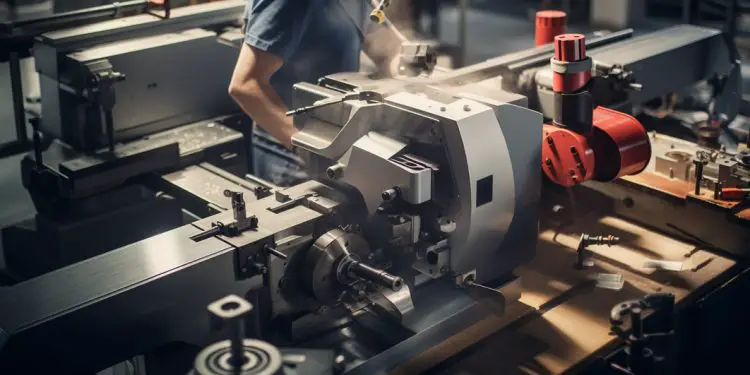How to Start and Grow a Cutting Tool Manufacturing Business: 3 Essential Factors

If you are looking for a lucrative business opportunity, you might want to consider starting a cutting tool manufacturing business. This is a type of business that makes and sells tools and equipment that can cut, shape, or remove material from different kinds of workpieces. For example, you can produce and sell saws, drills, lathes, milling machines, routers, grinders, and more. These tools and equipment are vital for many industries, such as woodworking, metalworking, construction, engineering, and manufacturing. There are several reasons why a cutting tool manufacturing business can be profitable. First of all, there is a high demand for cutting tools in the global market, as they are widely used in various sectors and applications. According to a report by Grand View Research, the global cutting tools market size was worth £55.8 billion in 2020 and is expected to grow at a compound annual growth rate (CAGR) of 4.5% from 2021 to 2028. Secondly, a cutting tool manufacturing business can benefit from economies of scale, as it can produce large quantities of tools and equipment at lower costs per unit. Thirdly, a cutting tool manufacturing business can differentiate itself from competitors by offering high-quality, innovative, and customized products and services that meet the specific needs and preferences of customers.
One example of such a cutting tool manufacturing business is Milo Tools, a UK-based company that has been providing cutting tools and solutions for over 40 years. Milo Tools offers a wide range of products, such as carbide inserts, end mills, drills, taps, dies, reamers, and more.
Factor 1: Choosing the Right Type of Cutting Tools and Equipment for Your Market
One of the most important factors for starting and running a successful cutting tool manufacturing business is choosing the right type of cutting tools and equipment for your target market. You need to conduct a thorough market research and analysis to identify the current and potential customers, their needs and expectations, the existing and emerging trends, the opportunities and challenges, and the competitive landscape. Based on this information, you can decide what kind of cutting tools and equipment you want to produce and sell, such as standard or specialised, general-purpose or application-specific, manual or automated, etc. You also need to consider the quality, performance, durability, safety, and price of your products, as well as the availability of raw materials, technology, and skilled labour.
Factor 2: Developing a Business Plan and Securing Funding for Your Venture
Another crucial factor for launching and operating a cutting tool manufacturing business is developing a comprehensive and realistic business plan that outlines your goals, strategies, and actions. A business plan is a document that describes the nature and scope of your business, the products and services you offer, the market analysis and segmentation, the marketing and sales plan, the operational plan, the financial plan, the risk assessment, and the exit strategy. A business plan can help you clarify your vision and mission, set your objectives and milestones, allocate your resources and budget, measure your progress and performance, and attract potential investors and partners. Securing adequate funding is also essential for starting and growing a cutting tool manufacturing business, as it requires a significant amount of capital investment for purchasing or leasing land, building or renting facilities, buying or leasing machinery and equipment, hiring and training staff, obtaining licences and permits, and covering other operational expenses. You can explore various sources of funding, such as personal savings, loans from banks or other financial institutions, grants from government or non-governmental organizations, crowdfunding from online platforms, equity financing from angel investors or venture capitalists, or debt financing from suppliers or customers.
Factor 3: Marketing Your Products and Services to Potential Customers
A third key factor for establishing and expanding a cutting tool manufacturing business is marketing your products and services to potential customers. You need to create and execute an effective marketing plan that shows your target market, your value proposition, your unique selling points, your pricing strategy, your distribution channels, your promotional methods, and your customer relationship management. You can use various marketing tools and techniques, such as online and offline advertising, social media, email marketing, content marketing, search engine optimization, trade shows, exhibitions, referrals, testimonials, etc. to attract and engage your audience, generate leads, convert sales, and retain loyalty. Moreover, you also need to track and evaluate your marketing efforts and outcomes, and make adjustments as needed.
How to Sustain and Expand Your Cutting Tool Manufacturing Business
To sum up, a cutting tool manufacturing business is a profitable and rewarding venture that can provide you with a steady income and a competitive edge in the market. However, it also involves a lot of challenges and risks that you need to overcome and mitigate. To sustain and expand your cutting tool manufacturing business, you need to focus on the following aspects:
✔ Choosing the right type of cutting tools and equipment for your market
✔ Developing a business plan and securing funding for your venture
✔ Marketing your products and services to potential customers
By following these steps, you can create and grow a successful cutting tool manufacturing business that can meet the needs and expectations of your customers and stakeholders.










